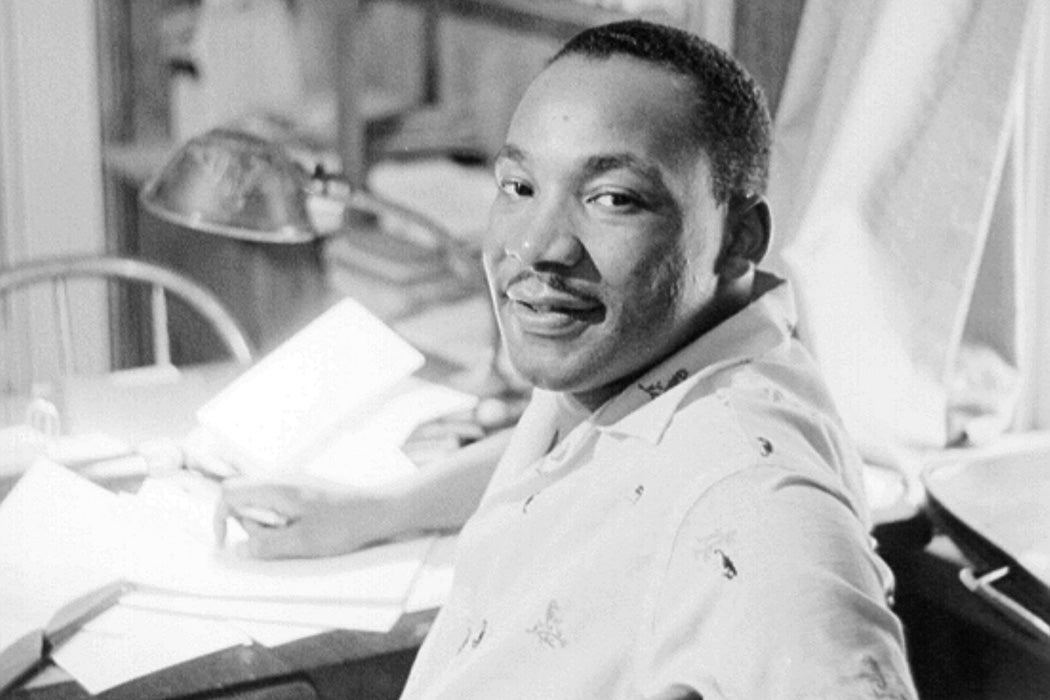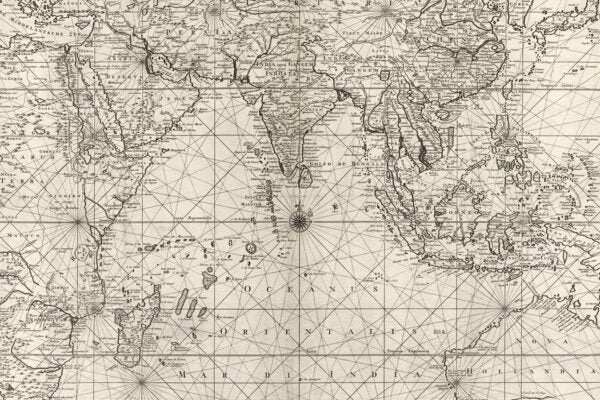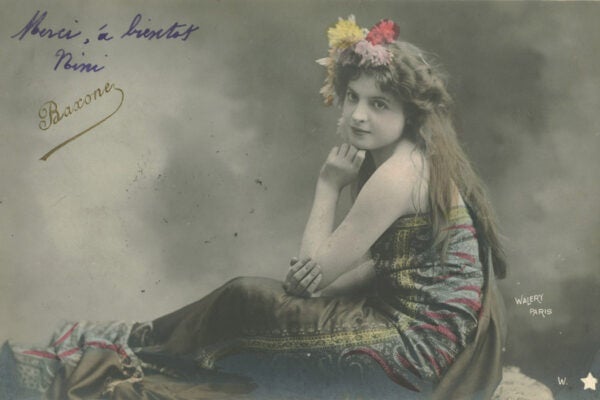“God has wrought many things out of oppression,” begins Martin Luther King, Jr.’s essay occasioned by the 1964 Berlin Jazz Festival. “He has endowed his creatures with the capacity to create—and from this capacity has flowed the sweet songs of sorrow and joy.”
There were names like Miles Davis, Sonny Stitt, and Roland Kirk on the bill. The 1964 festival was the first of the series, and it stood as a celebration of the genre, a recognition of the global impact of jazz. And now a big name was lending his support to the music: civil rights leader Martin Luther King, Jr.
Weekly Newsletter
In an earlier visit to Berlin, King had talked about the freedom movement’s work throughout the American South, and how he believed that “the Negro is called to be the conscience of our nation.” Nowhere was that call clearer than in jazz. Although King did not attend the festival in person (as scholars later confirmed), his address appeared in the program. There, in that divided city, King, a man who was fighting so hard against the divisions in his own country, was making the connections between the music and the movement.
It was beautiful music, no doubt about it. It was joyful, contemplative, and moving. But it was also a powerful tool in the fight for civil rights. It was music whose greatest stars were Black, and in a country filled with oppression of Black people, that was revolutionary. By the time King gave his speech, the connections between jazz and activism were only getting stronger, both at home and globally. The question isn’t so much why King would speak about the music, but how much of a role jazz played in Black liberation.

There are too many moments, too many painful scars, to name: Emmett Till. The Little Rock Nine. The 16th Street Baptist Church bombing. Too many names and dates and times and places that all amounted to an understanding shared by so many Black Americans: we are not safe. Any of those could have been the one hurt too many that pushed the music into the activist world. Jazz was the perfect artform for the struggle, as just the act of performing, of seeing these powerful Black men and women commanding stages and demanding to be seen as artists was itself “a rebellious political act,” as the scholar Ingrid Monson points out in the Black Music Research Journal. Jazz was changing. While the big band era was a popular and successful one, by the 1940s, younger musicians were looking for a bolder way to assert themselves musically, and bebop was just the thing.
In a 1962 essay about the birth of bop, Amiri Baraka wrote that “the musicians who played it were loudly outspoken about who they thought they were. ‘If you don’t like it, don’t listen’ was the attitude.” This was exactly the kind of self-assertion that earned them a range of reactions—from distaste to outright violence—in so many aspects of American life. But there on stage there was freedom. Without a doubt, it was a powerful image: Black artists commanding the attention of a roomfull of active listeners.
But image isn’t action. Jazz music took a decidedly more political tone, and the players a more active role in the struggle for civil rights. The music was not only providing a soundtrack for liberation, the musicians were becoming more visible in the fight, some in ways they’d never planned.
In April 1956, Nat “King” Cole took the stage in Birmingham, Alabama. After scoring a number of hits with his jazz trio, Cole had transitioned to his more pop-oriented solo work, which cemented him firmly as a crossover artist—a crooner with mass appeal. These were songs that would go on to become Christmas and wedding staples. They were romantic, upbeat, and emotional. What they certainly weren’t was controversial. But in the segregated South, Cole’s visibility and appeal made him a target for racists. They saw in his act, in his integrated band, and in his popularity “an even more insidious threat than strutting rhythm and blues singers,” as the music scholar Mark Burford explained. About three songs into his performance, Cole was attacked on stage.
Maybe, earlier in the decade, more people would have rallied around Cole. But the Black press at the time saw Cole’s playing for a segregated audience as tantamount to an endorsement of the practice. The Amsterdam News wrote that Cole had “agreed to humiliate himself and his race and sell his talents under Jim Crow conditions.” The NAACP’s executive secretary pointed to the incident as a prime example that “organized bigotry makes no distinction between those who do not actively challenge racial discrimination and those who do.” He urged Cole to join them in fighting the conditions that led to the attack.
There were no more sidelines. Jazz musicians, like any other American, had the duty to speak to the world around them, and to oppose the brutal conditions for Black Americans. After the Birmingham attack, Cole told reporters: “I can’t come in here on a one-night-stand and overpower the law. […] But I can help to ease the tension by gaining respect of both races all over the country.” And, in the early 60s, Cole announced his fundraising efforts on behalf of several civil rights organizations.
Jazz also found itself on the global stage well before King’s Berlin remarks. That image of American cool, of smoky jazz clubs and late night music, was an easily exportable one—and a way to promote the idea of just how much America loved and respected its Black citizens. Something that would change the conversation from Black churches being bombed; or Black children being attacked for trying to attend school; or the fact that all our Cold War adversaries had to do to reveal the U.S.’s limited view of freedom was to show pictures of attacks on Black protestors.
The U.S. needed a makeover, to present the nation on a world stage as open and accepting, and who better than jazz musicians? The music was popular, the players even more so. With a push from New York Congressman Adam Clayton Powell, in 1956, President Eisenhower launched the Jazz Ambassadors program through the State Department, with the trumpeter Dizzy Gillespie as its first Ambassador.
But this move exposed the exact attitudes the program was designed to cover. Louisiana senator Allen J. Ellender said: “To send such jazz as Mr. Gillespie, I can assure you that instead of doing good it will do harm, and the people will really believe we are barbarians.” The White Citizens Council of Alabama, which was, unsurprisingly, the same group behind the attack on Cole, agreed, calling the music a “plot to mongrelize America.”
Before he was to leave on his tour of several Middle Eastern and Eastern European countries, Washington officials asked Gillespie to come in to be briefed, to make sure he knew what to say when asked about American racism. He refused, saying, “I’ve got three hundred years of briefing. I know what they’ve done to us. If they ask me any questions, I’m gonna answer them as honestly as I can.” This wasn’t about making excuses for America, he said, or about letting himself be used as a prop in an America-produced stage play for race relations. This was about the music for him, and, yes, in some ways, about the image.
That image of Black artists on a world stage was important both to his work and to the genre as a whole. When Gillespie returned from the tour, he praised the program, and advocated for its expansion. The program did continue, adding names like Dave Brubeck, Duke Ellington, and Louis Armstrong.
Armstrong, who participated beginning in 1960, was actually asked to lend his talents to the program in 1957 but refused because of the treatment Black people were getting at home: “The way they are treating my people in the South, the government can go to hell,” he said. His was an interesting case because Armstrong was, to put it lightly, a complicated figure in Black America at the time. In a 2006 interview, Amiri Baraka recalled what he, and other detractors, thought of Armstrong and his act at the time: “We confused what we perceived as the social demeanor in that context of lynching. And we thought that Louis was submitting to that. […] When it was possible for Louis to speak, he spoke.”
Armstrong wasn’t alone. Pianist Thelonious Monk had never been at the forefront of the movement, stating in a 1958 interview: “My music is not a social comment on discrimination or poverty or the like.” But 1958 in America was hardly a time for silence. Those in opposition to equality certainly weren’t staying silent. That year a bomb plot was thwarted at a Baptist church in Birmingham (this was the second bomb placed at the church in less than two years), and across the South desegregation orders were being ignored—violently so. The battle for rights were coming toward the willing and unwilling activist alike.
This might have been why a political agnostic like Monk performed at a 1963 civil rights benefit for the Student Nonviolent Coordinating Committee. As Monson noted, this was a move that fit well into the long history of jazz musicians performing for explicitly activist causes. In the past, musicians had performed at benefits for the Scottsboro boys, the Freedom Rides, the NAACP, and, later, the lunch-counter sit-ins. Monk would be part of a tradition that included musicians like Duke Ellington, Abbey Lincoln, and Clark Terry, musicians who were contributing their talents to the fight.
It’s not surprising to find themes of liberation, anger, and resistance in the music. “Jazz speaks for life,” King said in his address, and there are a host of examples of jazz doing just that, speaking not just to American life but to Black American life, to the pain and joy contained in that. “My only sin is in my skin,” Louis Armstrong sang in “(What Did I Do to Be So) Black and Blue” (Fats Waller’s 1929 composition, with lyrics by Harry Brooks and Andy Razaf). There’s a 1965 performance of the song that Armstrong made ache with its era, or maybe less than its era and more with lived experience. It’s what King described in his address as musicians “affirm[ing] that which was stirring within their souls.” Even today, the song has a quiet resonance in a country that still stumbles and falls when it comes to equality.
It’s the type of resonance felt in the Abel Meeropol’s composition “Strange Fruit.” The song, whose most well-known version was performed by Billie Holiday, is a painful meditation on the country’s violent legacy of lynching. Music couldn’t ignore that violence, and many other pieces spoke directly to it: John Coltrane’s “Alabama” (1963) was a tribute to the four girls killed in a bombing at the 16th Street Baptist Church; Charles Mingus’ “Fables of Faubus” (1959) was an indictment of Arkansas’ pro-segregation governor Orval Faubus; and Nina Simone’s “Mississippi Goddam” (1964) was written in response to both the murder of civil rights leader Medgar Evers and the Birmingham church bombing. “How,” Simone said in an interview, “can you be an artist and not reflect the times?”
Because the struggle for civil rights was also a fight simply to be seen and valued, there were songs celebrating the beauty of blackness, like Mongo Santamaria’s “Afro Blue” (1959, with lyrics by Oscar Brown, Jr.); Duke Ellington’s 1963 album My People; and Nina Simone and lyricist Weldon Irvine’s “To Be Young Gifted and Black” (1969). There was even music imagining a different, freer, less Earth-bound existence, like the Afro-futuristic Sun Ra, whose Space is the Place (both an album and a soundtrack for a film of the same name) made Black liberation the stuff of the cosmos. Jazz music, King declared, was the ability to take the “hardest realities of life and put them into music, only to come out with some new hope or sense of triumph.” Jazz was recording its time, and giving strength to those fighting for a better world.
Music was even used to advance and support political campaigns, either directly, like how Dizzy Gillespie’s reworked the lyrics to “Salt Peanuts” in 1964. The resulting piece, called “Vote Dizzy,” served as a campaign song for his presidential run. His platform included renaming the White House the Blues House, and putting musicians like Peggy Lee and Miles Davis into cabinet positions. While it was a satirical campaign, Gillespie donated the money he raised to civil rights organizations.
There was also the Parker-Coltrane Political Action Committee, established by Congressman John Conyers in 1981, which aimed to elect progressive Black politicians in Southern states. The PAC’s board included jazz musicians Nancy Wilson, Johnny Hartman, and Joe Williams. When asked about the PAC’s choice of names, Conyers answered, “politics is everybody’s business, including people who dig great jazz.”
Jazz was another tool for activism. Everything from the compositions that left no question about their politics, like Sonny Rollins’ 1958 “Freedom Suite,” to the album covers like Max Roach’s We Insist!, which mirrored a lunch counter sit-in, showed that these artists were as much a part of the fight as anyone. Jazz was a powerful part of the civil rights movement, and King’s presence in the festival only strengthened the bonds.
“Much of the power of our Freedom Movement in the United States has come from this music,” King noted. The music spoke to Black life, but also to a human condition, a need to be seen, to be heard, to have your life matter. And indeed, even King’s own life would be eulogized by jazz, in pieces by Duke Ellington and Nina Simone. King noted that everyone needed love, happiness, and faith. Jazz, he wrote, “is a stepping stone towards all of these.”







